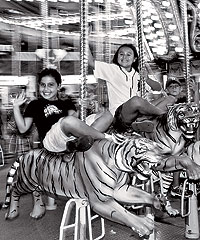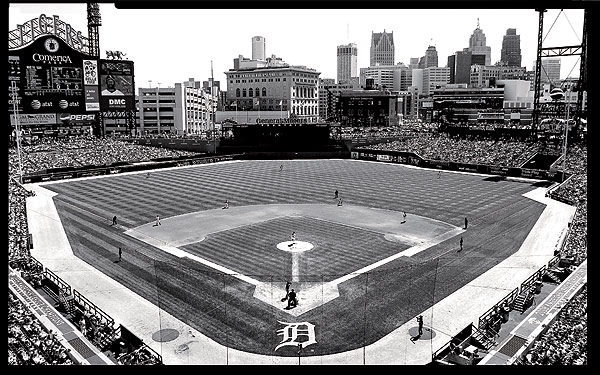
Tiger, tiger: Detroit’s Comerica Park hosts the Chicago White Sox in 2007.
Baseball fans love to lament the Disneyfication of their ballparks. The argument goes something like this: Major League Baseball has sold out to corporations and to casual fans who need more than a slow-moving game to keep them interested. In doing so, baseball’s keepers have betrayed the game’s sacred rhythms and flattened the idiosyncrasies that once made each park a singular experience. Sure, the changes have been effective in their way—attendance is the highest in decades, and in a recent SI.com survey, fans overwhelmingly backed the new stadiums. Still, the traditionalists insist, much has been lost.
As a longtime fan and a White Sox die-hard, I am required to say I despise U.S. Cellular Field (built in 1991). OK. But then I recall games at Comiskey Park. It was an uncomfortable place. Dirty. The lines were brutal. I couldn’t see. It smelled kind of funny. The game being played at The Cell isn’t much different from what it was at Comiskey, so the question is: Can a clean, accessible ballpark boasting assorted entertainment off the field coexist with the real game? Must our baseball experience be unpleasant to be considered authentic?
Chicago is a great baseball city, but it also has a geographic advantage for considering these questions. From my desk downtown, I count seven big-league ballparks within reasonable driving distance: Wrigley Field; U.S. Cellular Field; Milwaukee’s Miller Park; Detroit’s Comerica Park; Cincinnati’s Great American Ball Park; St. Louis’s Busch Stadium; and Cleveland’s Progressive Field. Many regard the 94-year-old Wrigley as the jewel in the crown of traditional baseball; the other six parks have gone up in the past 17 years.
In July 2007, I found a stretch of the major-league schedule that conspired for a test: seven days, seven games, a minimum of driving. When I asked my father to come with me, there were no ulterior personal motives. We had no wounds to heal, no generation gaps to bridge through the magic of baseball, à la Field of Dreams. Nor were we seeking any great truths about America, or each other. We simply enjoy spending time together, and wanted to compare the new parks with one of the oldest.
Note: If you’ve got a week at your disposal and want to make a similar road trip this summer, a good bet is August 31st through September 6th, when you can cover 1,500 miles around the Midwest and see seven games, five states, and 12 different teams in one week. As for tickets, any number of affordable seats (usually $15 to $35) are available for most games if you know where to look. Stubhub.com, eBay, and craigslist.org are good places to start. Regarding food prices: Unless otherwise noted in this story, they’re pretty much the same all over. Except in St. Louis, where they’re a total rip-off.
Photograph: Mark Cunningham/Courtesy of Comerica Park
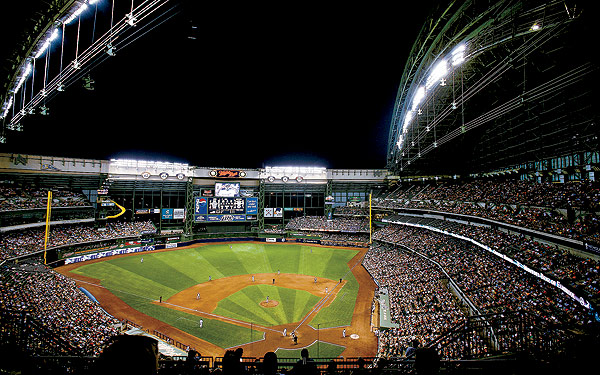
Raise high the roof: Milwaukee’s Miller Park
|
MILLER PARK Opened 2001 Capacity 41,900 Little-known fact Some seats behind home plate are closer to the catcher than the pitcher is. Brewers indeed After singing "Take Me Out to the Ballgame" during the seventh-inning stretch, the crowd launches into "Beer Barrel Polka." And yet . . . No beer holders on the seats—at least not in our row Surprise The bathrooms are cleaner than a dentist’s office. What to order Miller High Life draft; brat slathered in Secret Stadium Sauce What to avoid $10.50 bloody mary Lest you forget it’s Wisconsin Friday fish fry: $9 for three pieces plus coleslaw Smart Three alcohol-free family sections Even smarter If you’re too drunk to drive, management may spring for a taxi. |
GAME 1
San Francisco Giants vs. Milwaukee Brewers
Miller Park, Milwaukee
July 20, 2007
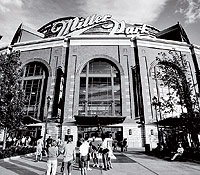 |
|
ODOMETER:
186 miles roundtrip from Chicago to Milwaukee |
"Is that the art museum?" I ask, half kidding, when we spy the ballpark in the distance. Miller Park has little in common with Santiago Calatrava’s remarkable addition to the Milwaukee Art Museum beyond the fact that both were completed in 2001. But the striking ballpark, with its 12,000-ton metallic retractable seven-panel roof, turns heads with the same frequency.
The long walk from our car to the stadium is torture. Wisconsinites have turned tailgating into an American art form; the whole parking lot may as well be paved with kielbasa. Dad and I brought no provisions, an error that few locals make, and by the time we pass Klement’s Sausage Haus and a sudsy beer garden rocking to the sounds of Lil’ Mel & the TKO Band, we’re ready to devour anything not nailed down. And we’re still in the parking lot.
Once inside the park, our eyes are drawn, again, to that soaring roof. It’s been the source of much talk in Milwaukee, very little of it good: It costs too much. It leaks during rainstorms. It casts shadows on the field. They’ve fixed it now, but for a time, the noise of it closing was unbearable. "Imagine the sound of 10,000 fingernails being dragged across a giant chalkboard, and you have an idea of how bad it sounded," quipped Kevin Reichard of ballparkdigest.com. But the park has become a symbol of how Wisconsinites zig where others zag. In an era when American cities bent on urban renewal unveil charming retro ballparks downtown, Milwaukee built a giant airplane hangar in the Menomonee River valley, nearly five miles from downtown—all the better for tailgating.
|
|
"What’s with the carnival music everywhere?" asks my dad, who notices music wherever he goes even when you didn’t realize there was any playing. People have likened new stadiums to theme parks and Miller even sounds like one, a vibe that the Brewers’ Web site manages to capture in two sentences: "There’s more to a game at Miller Park than just the baseball. It is a total entertainment experience." The spacious field level is full of gift shops, exhibits, a bat factory, a batting cage, and a place to create your own baseball card; there is a picnic-like area in the right-field loge bleachers called The Beerpen. And, of course, enough Leinenkugel taps to get half the county drunk.
Our seats are behind home plate, up high—though not as high as the $1 "Uecker Seats," partially obstructed spots named for the Brewers’ announcer Bob Uecker. The field looks pristine, and the people in our section are nice, though not terribly into the game. For amusement, a group of teenage girls behind us count on the ballpark’s constant contests, trivia quizzes, and the "kiss cam." They’re particularly obsessed with Bernie Brewer, the mascot who loiters in "Bernie’s Dugout," beyond left field, waiting for a Brewer to hit a home run so he can fulfill his destiny and skid down a slide onto a platform near the foul pole. (In the old stadium, Bernie resided in some kind of chalet with his own keg and slid into a beer stein, but times are tough.)
During the sixth inning, the crowd awakens. In one of baseball’s funniest (new) traditions, five giant sausages with oversize heads—a bratwurst, Polish, Italian sausage, hot dog, and chorizo—race around the field. The ritual has spawned copycats around the league, from Pittsburgh’s pierogis to Washington’s four Mount Rushmore presidents.
In Milwaukee, Chorizo is victorious tonight. Around the park, bets are paid off in beers.
The Brewers, who are behind all evening, can’t inspire the same enthusiasm. By the seventh inning the teenage girls are gone, and no one homers tonight, so Bernie stands for most of the game, looking embarrassed. So do the Brewers, who lose 8-4.
Photography: (Images 1 & 2) Scott Paulus; (Image 3) AP Photo/Morry Gash
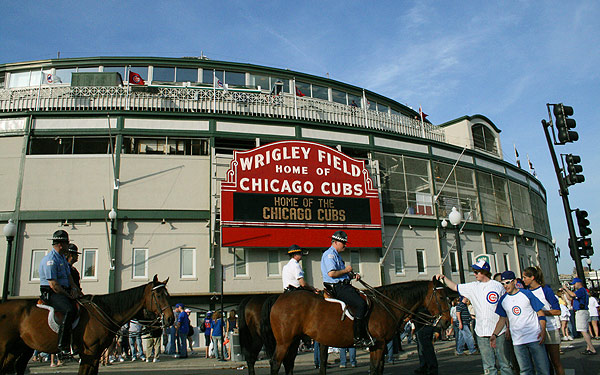
|
WRIGLEY FIELD Opened 1914 Capacity 41,160 Good trivia No home run has hit the scoreboard since it was moved to its current spot in 1937. The last man to come close was Roberto Clemente in 1959. Great tradition Flag visible from el with a blue "W" signifying a Cubs win What to order Old Style; Best Kosher dog with sautéed onions What to avoid The bathrooms. Men’s urinals are those skeezy communal troughs, and lines are long. We saw one guy peeing in the sink. Best bet for a free ball Go early and see if you can beat the hawks on Waveland Avenue to a batting-practice home run. Great olde tyme touch Roaming Dixieland jazz band in stands If you must barhop Skip the packed nearby beer scrums and try Goose Island Brew Pub south on Clark Street. It’s usually packed, too, but at least the beer is good. |
GAME 2
Arizona Diamondbacks vs. Chicago Cubs
Wrigley Field, Chicago
July 21, 2007
|
ODOMETER:
5.4 miles roundtrip from home to Wrigley |
It’s a beautiful Saturday afternoon, and Wrigleyville smells like beer. It also smells like money: After failing to score tickets on eBay, we’re forced to buy from a scalper on Clark who wants $140 for two seats in section 237. That’s the lower terrace on the first-base side, partially obstructed behind a steel girder. Uecker seats at Trump prices.
As we’re walking up the ramp to our seats, Dad gets nostalgic about the ball games his dad took him to when he was a kid. "We’d drive in from Indiana, so the buildup was huge," he says. "The moment when we’d walk through the tunnel and first see that beautiful green field and the scoreboard . . . no matter how many times he brought me, it took my breath away every time." Not today, though. With the overhanging terrace blocking much of the landscape from our section, we’re robbed of that indelible moment.
While I always enjoy a game at Wrigley, soon after we sit down my gripes come rushing back. For starters, the family-friendly reputation. Children tend not to be baseball purists, and while Milwaukee may go overboard with all the stuff, Wrigley promises nothing but the action on the field. And sure, the atmosphere is congenial, but it ain’t G-rated. The meathead behind us keeps complaining that his Carlos Zambrano bobblehead doesn’t resemble the Cubs fireballer at all: "It looks like the Mexican president—what the @#$% is his name? Vincent Fox?"
But the misperceptions cut both ways. Wrigley doesn’t deserve its notoriety for drawing a crowd interested predominantly in drinking and socializing. The beer flows abundantly in section 237, but even the rowdy fans know their baseball. (Maybe it’s a different story in the bleachers.) When Alfonso Soriano makes an error, a guy down the row informs everyone that it was only his second of the year. In fact, on this trip, we find no fans more spirited and knowledgeable about the game than the Cubs faithful. As a Sox man, I admit this grudgingly.
Whether we care for the people or not, the Wrigley experience is undeniably memorable. First off, with the el passing by beyond right field, apartment buildings looming in the distance, and sirens blaring from a nearby firehouse, the ballpark never lets us forget we’re in the middle of a city. Toss in the ivy and the iconic manual scoreboard, and you’re transported. A relative lack of advertisements and interruptions on the PA system means there’s nothing much to do but watch baseball and talk. And no one today needs a scoreboard to tell him when to make noise; they belt out "Take Me Out to the Ballgame" so loud, you can barely hear the comedian Dennis Miller leading it from the booth.
Unfortunately, the Cubs offense musters only four hits all day, and the pitching officially blows the game on a home run in the eighth. The chant begins: "THROW IT BACK . . . THROW IT BACK . . . ," instigating another Wrigley tradition: regurgitating an opponent’s home-run ball as a sign of—what? Disrespect? Disappointment? Anger? The bleacher bum who catches this one seems reluctant to part with it, but soon the chant is overwhelming, and there’s only one way to shut them up. The second he heaves it, the crowd erupts, and he appears pleased with his decision. When it comes to Cubs games, one man is powerless against the tide of history.
Photography: Esther Kang
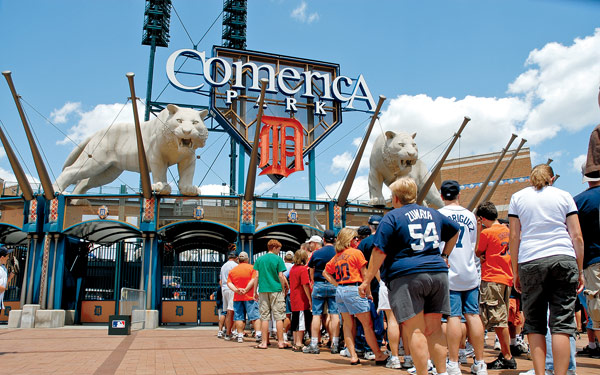
Stone tigers prowl the entrance to Comerica Park
|
COMERICA PARK Opened 2000 Capacity 41,782 Great tradition Friday night fireworks Tired tradition Entire crowd sings "God Bless America" in the seventh inning. Cheapskate alert Look into a $15 SRO spot beyond outfield: good view, lots of room to spread out. Lest you forget it’s Detroit The ivy-covered General Motors Fountain beyond center field is topped with Chevys. Free stuff Copies of today’s Detroit News for adults; face painting for the kids Vaguely creepy The clapping digital hands on the scoreboard What to order Coney dog; Cajun peanuts; elephant ears; 32-ounce Labatt’s What to avoid Anything involving Little Caesar’s. Owner Mike Ilitch, who also owns the Tigers, is getting enough of your money. Regarding parking Don’t be a hero. Just pay the $15 to park in the Tigers lot. |
GAME 3
Kansas City Royals vs. Detroit Tigers
Comerica Park, Detroit
July 22, 2007
|
ODOMETER:
290 miles from Chicago to Detroit |
Our first introduction to Motown comes in a dilapidated lot near the stadium, courtesy of a man who may be a parking attendant or maybe some guy just hanging out. He wants $5 to "watch" our car while we’re at the game, which seems more threat than deal, so we fork it over. Welcome to Detroit.
While the city has taken its lumps over the years, "Foxtown," a revitalized entertainment district around Comerica Park, is pretty spiffy. They call the area an "urban village," and that’s a fairly accurate description for this grouping of theatres, restaurants, bars, and shops, anchored by Ford Field—the Lions’ home—and Comerica Park.
|
|
Detroit has been slow to warm to CoPa’s gleaming fun-park vibe: Their hearts belong to Tiger Stadium, which closed in 1999. With its goofy dimensions, comically dreadful bathrooms, and shabby charm, it was the weirdest ballpark in the league, and one of my favorites. For this reason alone, I was ready to hate Comerica. The new 31-acre park doesn’t try to recall Tiger Stadium. A mere 24 hours after wrapping ourselves in the century-old charms of Wrigley, Comerica’s sterile, remote setting comes as a culture shock. From our seats in row L of the left field bleachers, the action feels miles away.
But the ballpark is a pleasant spot to spend three hours. HOK Sport, the architects, got some things right, such as spacious seats, room for plenty of vendors, and terrific sightlines. In fact, no matter where I go in the airy concourse, the game is visible. The players look like tiny animatronic robots, but at least you can see them.
The Tigers have a colorful history, and Comerica—if you can look past the food court behind home plate and a Ferris wheel with gondolas shaped like baseballs behind third base—pays homage to that history. A Tigers Hall of Fame lurks beyond center field with bronze busts of legends such as Greenberg, Kaline, and Cobb; around the concourse, lively exhibits break down the team’s many peaks and valleys over the decades. Dad is smitten by it all. "I would’ve taken you to a lot more games if parks back then had all these rides and gift shops and museums," he says.
|
|
Only eight years old, Comerica is still searching for an identity; some traditions feel a little shoehorned. When a Royals player jacks a homer in the seventh, fans holler, "THROW IT BACK . . . THROW IT BACK," and the poor guy who caught it does. The tradition, so natural at Wrigley, seems out of place here, where people don’t appear to have any real malice toward their opponents. Even the ritual following a Tigers home run is lame: Atop the 33-foot scoreboard in left field, the eyes of two giant prowling felines light up. The crowd barely seems to notice.
In what’s becoming a disturbing trend, the home team loses again. Sunburned and exhausted, Dad and I drive to the suburbs and bunk at the lovely Southfield home of Alicia and David Nelson. David is a Conservative rabbi and Tigers fanatic who has attended every opening day for 36 years. "The first day of the first season at Comerica was hard," he said. "I felt we had left an old friend standing in the dust. Then I walked around and saw all the new features . . . I feel disloyal to Tiger Stadium, but I’ve come to enjoy Comerica Park."
Photograph: (Images 1 & 3) Mark Cunningham/Courtesy of Comerica Park; (Image 2) AP Photo/Amy Sancetta
|
PROGRESSIVE FIELD Opened 1994 Capacity 43,345 Nice touch Angled seating beyond the dugouts gives fans a view of the diamond "minus the crick in the neck." Convenient $12 parking just steps from left-field bleachers Great tradition John Adams, the longtime fan who has been pounding his bass drum in the bleachers for 35 years Looks like fun KidsLand near right-field foul pole includes toy cars, wagons, slides, and houses. True fans only $150 buys you a brick engraved with a personal message in Heritage Park. What to order Cleveland Bomber: a burrito stuffed with Italian beef, mozzarella, and peppers What to avoid A "Go Yard" frozen daiquiri Bargain alert You can get four seats, sodas, and hot dogs for $51 on Sundays. |
GAME 4
Boston Red Sox vs. Cleveland Indians
Progressive Field, Cleveland
July 23, 2007
|
ODOMETER:
170 miles from Detroit to Cleveland |
We’re instant targets when we arrive at Progressive Field. Batting practice is still going on, which means the visiting big guns, Boston’s David Ortiz and Manny Ramirez, are cracking homers left and right into our section in the left field bleachers. Before we even sit down, a scorching shot from Big Papi almost plunks Dad in the noggin.
It doesn’t take long to realize that our section is populated by Boston fans. (The couple next to us with a baby in a Red Sox onesie is the first clue.) The Red Sox nation is so powerful and so irritating it pretty much takes over the ballpark tonight, which is a shame, because Tribe fans are generally a proud folk.
Baltimore’s Camden Yards kicked off the retro ballpark trend in 1992, but Progressive Field (known as Jacobs Field until this season) is generally considered the best example of the form. Locals have loved "The Jake" since the day it opened in 1994. But, in typical Cleveland fashion, Progressive Corp., a local insurance company, managed to alienate the bulk of Indians fans by laying off 341 workers in 2007, then promptly spending $58 million to put its name on the stadium. Most fans, understandably, still refer to it as The Jake.
Whatever you call the park, it’s holding up nicely. The relative lack of video screen graphics and distractions competing for attention is a welcome respite. After three days of beer and hot dogs, the wide aisles are a relief. And an outdoor beer garden/picnic area beyond center field feels like a natural extension of the park instead of something plucked from a suburban strip mall. Heritage Park, a tree-shaded rotunda nearby, is downright magical considering how few of the players immortalized in it have hoisted a World Series trophy. Perhaps most touching is the old bronze plaque honoring Ray Chapman (1891-1920), the only player ever killed in a major-league game.
The view is great from the bleachers, especially if you’re a Red Sox fan. Boston quickly jumps out to a five-run lead, and coasts the rest of the way. That, combined with a steady drizzle, seems to have lulled the home crowd. A fuchsia-toned shag carpet of a mascot called Slider tries to pep up the proceedings with all kinds of forced entertainment. (I am told that Cleveland fans loathe Slider so completely that some cheered when he fell off an outfield fence in 1995 and tore his anterior cruciate ligament.) A pathetic attempt at starting The Wave, courtesy of some overmatched teenager in flip-flops, fails miserably. When it’s all over, the Indians have lost, 6-2, and the Boston fans file out smugly.
The home team is now 0-4 on this trip. We’re officially a jinx.
A couple of miles outside the ballpark, I get pulled over by a trooper for doing 77 in a 65. The cop is in good spirits, though, and lets us go with a warning. I might have imagined it, but his accent sounded vaguely Bostonian.
|
GREAT AMERICAN BALL PARK Opened 2003 Capacity 42,941 Nod to the past The scoreboard has a replica of the iconic Longines clock from old Crosley Field. Say it ain’t so Between innings, cheerleaders prance atop the Reds’ dugout. Other desperate measures Shooting T-shirts into crowd; adding a fuzzy red mascot named Gapper to the classic Mr. Red Good idea, bad art Tile mosaics of the 1869 and 1975 Reds near home plate Architectural gem "The Gap," a 35-foot opening in the stands that allows for views of the skyline—and a peek into the stadium from downtown. Water, water everywhere Plenty of fountains spread through the park What to order Montgomery Inn pork sandwich or a Big Red Smokey (a crusty burnt sausage); 44-ounce soda What to avoid Having to park in Kentucky |
GAME 5
Milwaukee Brewers vs. Cincinnati Reds
Great American Ball Park, Cincinnati
July 24, 2007
|
ODOMETER:
248 miles from Cleveland to Cincinnati |
With hours of car time and nothing but Ohio fields to distract us, Dad and I fade in and out of conversation. Nothing too deep, like What It Means to Be a Father or How We’re Feeling or anything like that. Mostly, we talk about baseball. As White Sox fans, we reminisce about the 2005 World Series.
"Remember Konerko’s grand slam in game two?"
"And Uribe’s catch in game four?"
"Man, what a great team that was."
It was only a few years ago, but it may as well have been 30. That’s the way baseball memories are. The second the season ends, it’s sealed in a time capsule and you forget everything but the good stuff. If there’s no good stuff, you just forget everything.
* * *
We’ve scored top-notch seats in Cincinnati: left field bleachers, front row. That puts us so close to the action, we could almost give Adam Dunn, the Reds’ hulking left fielder, a wet willie. (We decide against it.) Joining us tonight are my brother and his brother-in-law, both of whom are thrilled to be invited, despite the Reds’ current losing streak. The ballpark is so empty, we can hear entire conversations from rows away, most of which are about how the Reds suck.
They didn’t always, of course, but since moving into Great American Ball Park in 2003, this once-proud franchise has not had a single winning season. It’s easy to take it out on the HOK-designed stadium, which the Cincinnati Enquirer columnist Paul Daugherty called "a cement island on a brown river." The park, whose majestic-sounding name actually comes from the Cincinnati-based Great American Insurance Group, has a clever riverboat theme that hasn’t been overdone. Two outfield smokestacks shoot off fireworks, exude mist, and evoke the city’s origins as a river town; above them is a riverboat rooftop, where the Reds’ owner, Bob Castellini, periodically sits. From the upper deck, you’ve got a nifty view of Kentucky’s rolling hills and passing boats on the Ohio River. As my brother points out, Riverfront Stadium, the Reds’ old metal doughnut of a home, had none of this, but it had good teams.
Free with our ticket is admission to the Reds Hall of Fame adjacent to the stadium—and to "Pete: The Exhibit," a blatantly partisan tribute to Cincy’s favorite disgraced son, Pete Rose. Frankly, all I need for my Reds fix is Crosley Terrace near the main entrance, which features bronze statues of legends such as Frank Robinson and Big Ted Kluszewski (bare biceps and all) in action.
Great American Ball Park boasts the best concessions of any stadium we’ve visited: fresh food, great beer selection, fair prices. The lack of lines certainly helps. While exploring the cavernous main concourse, I see a trim man sitting at a folding table. Turns out it’s the Reds legend George Foster. The Destroyer! A cog in the 1970s Big Red Machine! Used to arrive at ballgames in a limo! Now he’s sitting at a folding table, signing autographs for three kids. Strange days for Reds fans.
Adam Dunn, whom everyone here apparently hates, cracks a pointless home run in the eighth; fireworks explode. The only other player who creates any kind of passion tonight is Ken Griffey Jr. Last time I saw Junior, in 1994, he was the best ballplayer I’d ever seen. He’s heavier now, and his body has broken down repeatedly, but he still makes two incredible catches in right field that keep the game interesting. In left field, Dunn is so blasé he looks more interested in my dad’s hot dog. The Brewers, lackluster in Milwaukee four nights ago, must know we’re here, and prevail 5-3. No one’s too fussed, and I’m willing to bet George Foster split by the sixth inning.
|
BUSCH STADIUM Opened 2006 Capacity 50,345 Olde tyme touch Giant manual scoreboards in the concourse, brought over from the team’s former park Pretty nifty On the Cardinals’ Web site, you can click on any seating section in the stadium and check out its view of the field. Going green Busch has begun an effort to recycle all fan debris left after games. Kid-friendly detail In addition to the usual interactive ballpark games, the Family Pavilion in right-center field includes T-ball for the kiddies. Nice gesture All active military personnel get in free with an ID. Voice from the past The statue of Hall of Fame broadcaster Jack Buck Smart move The whole ballpark is smoke-free, but if you must, there are exit/re-entry areas at three gates equipped with ashtrays. What to avoid The shame of ordering El Birdos Gourmet Nachos What to order Buy me some peanuts and Cracker Jack. But be sure to hit an ATM first. |
GAME 6
Chicago Cubs vs. St. Louis Cardinals
Busch Stadium, St. Louis
July 25, 2007
|
ODOMETER:
349 miles from Cincinnati to St. Louis |
Dad’s got a plane to catch; he has to fly to Albuquerque and go back to work. When we hug goodbye at the St. Louis airport and he tells me how much it means that I invited him along, a sudden melancholia grabs me. I wish we’d taken pictures or caught a foul ball or had some kind of keepsake from the past five days, but there’s nothing beyond ephemeral baseball memories, the kind that fade and shift and morph into legends, even when nothing much happens. This time, I want to remember more than just the good stuff; otherwise my recollections of this trip will drench themselves in phony nostalgia. When it comes to my dad, I want to remember everything.
Cardinals supporters are a sturdy, jolly lot, perhaps the most loyal in baseball. During the 1998 season, most of those who caught Mark McGwire’s historic—and valuable—home run balls promptly returned them to the slugger. "It’s not mine anyway," they said, or, "It belongs in the Hall of Fame." This attitude may explain why they don’t complain about being stuck with an unimaginative money-suck of a ballpark. (They do whine about cheap owners, but that’s a baseball tradition.)
The trouble is the Cardinals’ rich history. They’ve won ten titles, so when it came time to build a new Busch Stadium in 2004, team brass insisted on something traditional. Instead of going retro-modern, the architects, HOK Sport, gave St. Louis a generic steel-and-brick behemoth meant to echo the buildings that surrounded it. With neither the perks of Comerica nor the warmth of Progressive, Busch has all the charm of Dick Cheney after a coronary bypass. As one fan posted on ballparksof baseball.com, "It’s almost as if they said to HOK, ‘Build us Camden Yards, but give us the Wal-Mart version.’"
Yet the Cards faithful put on red and pack the house every night. They plunk down way too much for Budweisers and Sno-Cones whether the team is an eventual World Series champ (2006) or an injury-riddled failure (2007). At the moment, locals are more concerned with the gaping mudhole across the street. It’s a prime slot of downtown real estate where a long-awaited $250-million entertainment district called "Ballpark Village" is planned, but due to political battles and a souring economy, ground has not been broken. It won’t be ready when St. Louis hosts the 2009 All-Star Game.
But tonight, there’s an electricity: The Hated Cubs are in town. An old friend, a reporter for Channel 11 in St. Louis, meets me outside the ballpark, where we spot almost as many anti-Cubs shirts as pro-Cardinals. Inside, same thing: People are ready to stomp the Cubbies. Our row (section 511, right field bleachers) is crammed so tight my elbow lands in my neighbor’s nachos.
Busch Stadium is a forgettable ballpark, but it’s not a bad one. For starters, seats down the foul lines are way closer to the field than they were at the old Busch; views of the game and the Gateway Arch are tremendous. The scoreboard and JumboTron are crisp and clear. Stadium employees are endlessly gracious. And in a rare egalitarian move, fewer corporate luxury boxes were built this time around. Although the concourse is small compared with, say, Cincinnati’s, it boasts a 360-degree view of the game. In St. Louis, the game’s the important thing.
Which makes it all the more painful when the home team gets spanked by its worst enemy, 7 to 1. The hordes file out crushed, but things aren’t all bad. Many in the crowd, including my reporter friend and me, head to Ted Drewes, the hallowed frozen custard stand on old Route 66. We sit on a wooden bench and eat thick cherry banana "concretes," because win or lose, that’s what you do after a Cardinals game, and it tastes good either way.
|
U.S. CELLULAR FIELD Opened 1991 Capacity 40,615 Great tradition Exploding scoreboard shoots fireworks you can see from the Dan Ryan. Lame corporate sellout Connie’s Pizza races on the scoreboard Say it ain’t so Scoreboard resorts to a fake noise meter to pump up the crowd. Worst-named kids’ area Pontiac FUNdamentals, an otherwise fine multilevel interactive space beyond left field Nod to history The seats where Paul Konerko’s and Scott Podsednik’s home runs landed in the 2005 World Series are blue. Other seats are green. Odd detail The shower near section 161, a carryover from old Comiskey What to order Overwhelming food selection, but go with a kosher dog, Miller Lite, and elote (roasted corn with mayo, Parmesan, and Mexican spices). What to avoid Driving. We paid $20 for parking and still had a long walk. Nice detail You can get a certificate commemorating a child’s first Sox game from Guest Relations. We got two. |
GAME 7
Detroit Tigers vs. Chicago White Sox
U.S. Cellular Field, Chicago
July 26, 2007
|
ODOMETER:
297 miles from St. Louis to Chicago |
I’ve got to haul ass to make it back to Chicago in time for a 1:05 game, which means I get pulled over again, this time near Normal. The guy clocks me doing 83 in a 65 and before I can win the guy over—You a baseball fan, Officer?—he slaps me with a $75 ticket.
My wife and kids meet me at U.S. Cellular Field for one last chance to see the home team leave happy. The wife’s a Cubs fan, and quick to begin the Cell-bashing, recounting all the usual grievances: The ballpark was the result of the owner’s threat to relocate to Tampa; it had the misfortune of preceding the retro-classic revolution that began with Baltimore’s Camden Yards; that steep upper deck gives people vertigo; the surrounding neighborhoods have zero attractions. Besides, she continues, the stadium is cold and impersonal. If you arrive by el, you’re forced to circumnavigate the park just to find the damn entrance, prompting a friend of mine to remark that the whole place seems to have turned its back on you.
My wife has old information. The Cell, the first major-league park built by HOK Sport (the company seemed to have gotten all of the mistakes out of its system with this design), has addressed several of the problems. The Sox removed nearly 7,000 seats from the upper deck and shifted the bullpens to make room for more bleachers. A nifty "Fan Deck" atop the center field concession stands now lends a breathtaking view of the field, the handiwork of the team’s legendary groundskeeper Roger Bossard. And, oh, yeah, the team won the World Series, which has a way of smoothing out even the roughest edges, because the park finally has some good memories attached to it. The Cell now has its own Champions Plaza outside Gate 4 with personalized bricks to honor the 2005 champions—a site so cheerful, even Juan Uribe gets his own statue.
I’ve been to dozens of games here, and it’s my team, so it’s hard to see it with an outsider’s eye. The first thing I notice from our seats (section 147, third-base side) is that the LaSalle Bank sign in right field may be the largest ad in any ballpark. (Either that or the ComEd sign in left.) Distracting LED "ribbon boards" flash numbers and ads all around the park. Hard-core fans of the old Comiskey may blanch at the pervasive corporate presence, not to mention sterile bathrooms and garden burgers at food stands with cutesy names like "Lollar’s Guard the Plate Grill." But it’s tough to find fault with the obligatory statues of Sox greats beyond center field, nor the vastly improved sightlines. I’m happier now than I ever was at Comiskey.
More troubling is the laid-back vibe of Sox fans. Maybe it’s because this is a day game, or a low-scoring battle, or Nancy Faust’s organ has hypnotized them. Or maybe the Sox nation is fat and happy because of that World Series trophy. But people are yawning. They’re quiet. They’re . . . bored? With baseball, on the South Side?
I’m just glad Dad’s not here to see it.
Still, after a single, a bunt, and a throwing error, the Sox pull out an exciting 4-3 win in the bottom of the ninth, and the good old South Siders have ended my six-game losing streak. The celebration, however, feels perfunctory. People leave the park quickly, and I’m among them, dragging two babies and a wife who still says The Cell stinks. She thinks the old ballparks like Wrigley, the creaky dinosaurs whose days are most likely numbered, will always be superior. Someday, when they’re old enough, maybe the tykes will share their opinions.




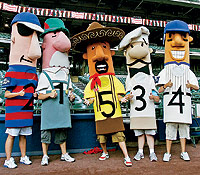
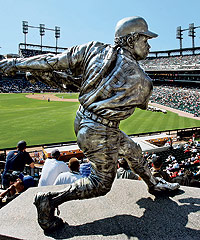 A statue honors Tigers slugger Willie Horton
A statue honors Tigers slugger Willie Horton